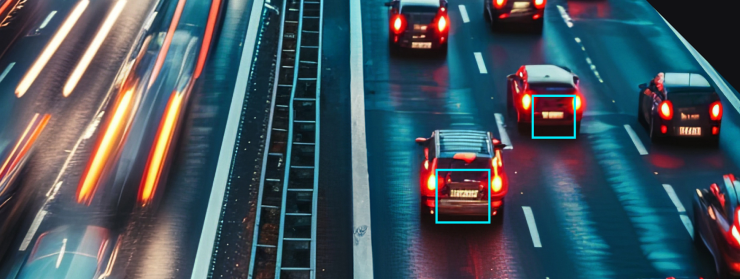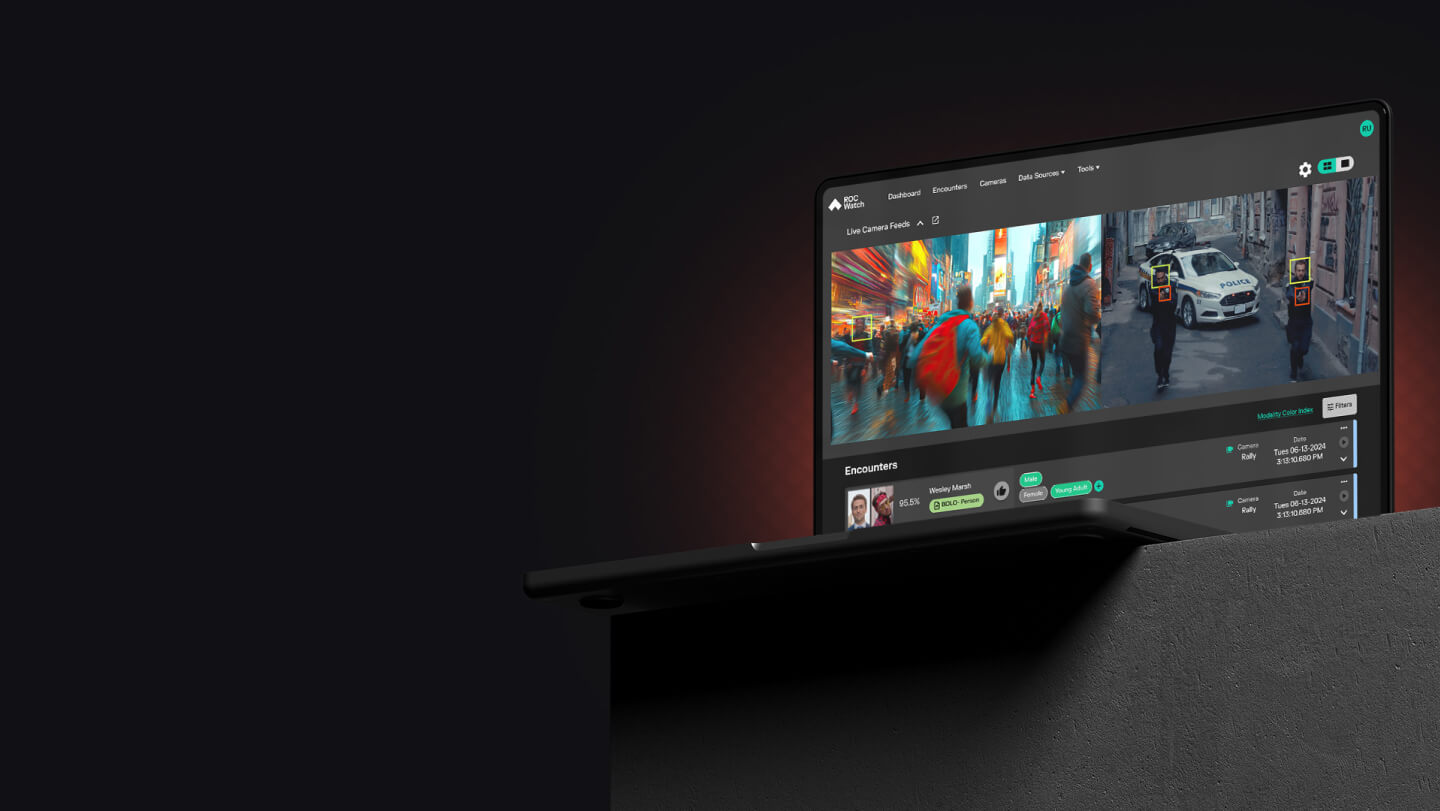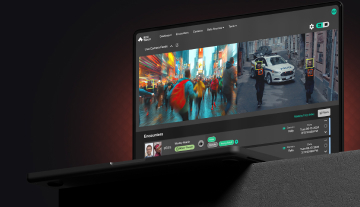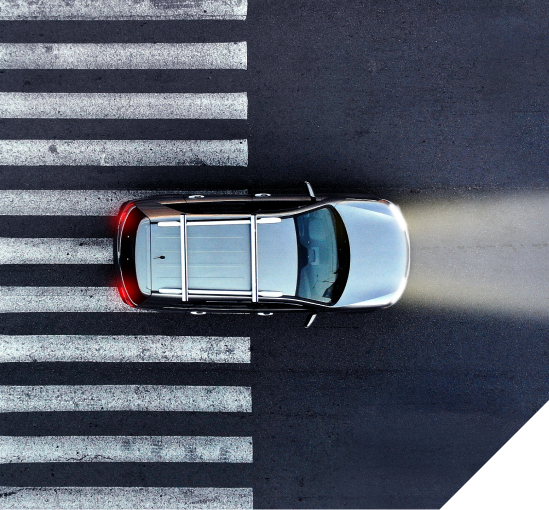Automated
License Plate
Recognition
Track vehicles across cities, borders, and timelines with global ALPR. Harness AI-driven vehicle recognition and video analytics to set new standards in speed, precision, and insight.

See beyond the plate. ROC Vision AI is a new dimension in vehicle recognition, transforming simple license plates into formidable vehicle profiles and turbocharged insights.
CAPABILITIES

Worldwide ALPR
Coverage
Get more coverage where you operate. Expanded license plate support for 69 countries across North America, Europe, and APAC.
Powerful Vehicle
Profiles
Harnesses the latest advancements in Vision AI to unlock a treasure trove of useful data, including vehicle make, mode, color, and year.
Intelligent Video
Forensics
Enhance your investigative capabilities with live and post-event video analytics, trusted by the U.S. military and law enforcement.
Hyper
Processing
Seamlessly process license plates in real-time from any device, even in challenging conditions like low-light, high-motion, or angled images.
FORMULA AI
for performance.
01
Easy to integrate
02
Lightweight and fast
03
Open and interoperable
04
Powered by responsible AI
next-gen vehicle recognition at
unmatched speed and scale.
and their patterns across thousands of sources in the most challenging conditions.
OUR PARTNERS
INCLUDE
Law Enforcement
You Drive. We Stay Ever Vigilant.
Proactive, intelligent ALPR monitoring for real-time crime centers, patrol cars, and bodycams. Identify stolen vehicles, wanted or missing persons, and hotlists in real-time with military-grade speed, precision, and scale.
Traffic Management
Build Smarter, Safer Roads
Track traffic at speed and scale across thousands of video sources. Analyze traffic patterns to manage congestion and optimize traffic flow. Improve road safety by identifying incidents in real-time and return to the scene with advanced video forensics.
Security & Surveillance
Prevent Incidents Before They Happen
Monitor public areas to identify suspicious objects or behavior and deter criminal activities. Arm security teams and first responders with play-by-play situational intelligence and video forensics to respond swiftly and efficiently to potential threats.
Fleet Management
Run More Efficiently
Streamline operations and revolutionize fleet safety with automated vehicle tracking. ROC offers real-time detection of vehicles, objects, and pedestrians, empowering you to make informed decisions while gaining greater control and insight into your fleet.
Smart Cities
Improve Public Safety and Urban Planning
Upgrade your command center and cameras with real-time intelligence. Optimize traffic flow, enforce parking regulations, identify stolen vehicles, manage access to restricted areas, monitor traffic patterns, and enable smart parking systems.
Emergency Response
Stay On the Front Foot
Detect traffic-related incidents as they happen and coordinate rapid response. Improve road safety by providing timely alerts and interventions to manage and alleviate congestion, and identify vehicles involved in accidents for faster resolution.

Deployed by
DOD | DOS | US NAVY | US MARSHALS | FBI
PRODUCTS

Your Instant Smart
Security Layer
Fully multimodal video intelligence with 24/7 proactive AI monitoring, badgeless visitor management, and threat detection.
PRODUCTS

Your Instant Smart
Security Layer
Fully multimodal video intelligence with 24/7 proactive AI monitoring, badgeless visitor management, and threat detection.

Reimagine What’s Possible
Tap into the power of the all-in-one ROC SDK. Integrate game changing biometric and Vision AI capabilities with just a few lines of code.

What is automatic license plate recogntion?
ALPR readers integrate high-speed cameras with AI-powered video analytics to automatically capture license plate information and other contextual information from images or video feeds. These systems are typically mounted on vehicles or fixed structures like traffic lights and use sophisticated image processing and optical character recognition for seamless data extraction. ALPR plays a critical role in traffic management, law enforcement, toll collection, and parking management. In law enforcement, for instance, ALPR can be used to track stolen vehicles, locate missing persons, assist in investigations, and monitor traffic violations such as speeding or running red lights.
Build with ROC.
Schedule a free trial or demo.
FREQUENTLY ASKED QUESTIONS
What is automatic license plate recognition (ALPR) technology?
How do license plate recognition systems work?
ALPR works by capturing an image of a license plate, pre-processing the image, localizing the plate, segmenting the characters, using OCR to recognize the characters, and post-processing the results.
Image capture
The first step in LPR is to capture an image of a license plate using a camera. The camera can be fixed or mobile and can capture images in different lighting conditions.
Pre-processing
Once the image is captured, pre-processing algorithms are used to improve the quality of the image. This can include adjusting the contrast and brightness of the image, removing noise, and enhancing the edges of the license plate.
Plate localization
In this step, the software identifies the license plate within the image. This can be done by looking for patterns or shapes that are characteristic of license plates.
Character segmentation
Once the license plate has been localized, the software separates the individual characters on the plate. This can be a challenging step, as license plates can vary in size, shape, and font.
Optical character recognition (OCR)
In this step, the software uses OCR algorithms to recognize and read the individual characters on the license plate. This can involve comparing the characters against a database of known characters or using machine learning algorithms to recognize patterns in the characters.
Post-processing
Once the characters have been recognized, post-processing algorithms can be used to validate the license plate number and correct any errors that may have occurred during the OCR process.
How is license plate recognition (LPR) used?
License plate recognition can support a wide range of corporate and community infrastructure needs, including:
Parking management
LPR can be used to manage parking in corporate and community settings. By using cameras to scan license plates, parking administrators can track the duration of a car's stay and issue citations to cars that overstay their allotted time.
Security
LPR can be used as part of a security system to monitor entrances and exits, or secure an event perimeter. For example, in corporate settings, LPR can be used to automatically grant access to authorized vehicles and employees, while denying entry to unauthorized individuals.
Law enforcement
Law enforcement agencies can use LPR technology to identify stolen vehicles, monitor traffic flow, and enforce traffic violations. By scanning license plates, law enforcement officers can quickly identify vehicles that are associated with criminal activity or outstanding warrants.
Toll collection
LPR can be used to facilitate toll collection on highways and bridges. By scanning license plates, toll authorities can bill drivers for tolls without requiring them to stop at toll booths.
Community safety
LPR can be used to improve community safety by identifying vehicles that are associated with criminal activity. For example, LPR can be used to monitor vehicles that are known to be involved in drug trafficking or other criminal enterprises.
Emergency management
License plate recognition technology can help streamline response and recovery efforts during and after an incident by providing real-time data on the movement of people and vehicles.
Do you support all license plates internationally? Which countries does ROC SDK support?
Can you read the "state" off of the U.S. license plates?
Yes, ROC SDK has the capability to automatically determine the state of origin on any domestic license plate.
What requirements do you have to read and recognize a car license plate?
ROC SDK will attempt to read a license plate captured at any side, but we recommend positioning cameras to capture license plates with a character height of at least 32 pixels for optimal accuracy.